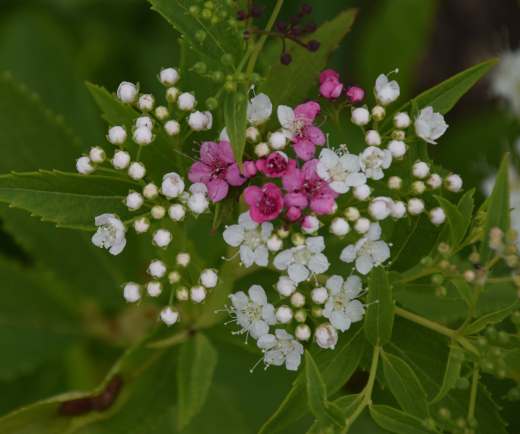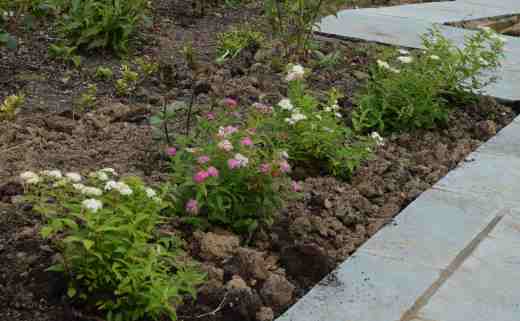Spiraea japonica ‘Shirobana’

As mentioned previously, the area around the summer house is to be planted simply. The idea is that I may have a chance of sitting and relaxing without seeing masses of things to do. ‘Futile I know, but that is the plan. Of course, things don’t go to plan and the summer house for which we had constructed the base, now has a 16 week wait, presumably because of the snarl up in the Suez Canal, even though it came from Scandanavia – who knows what route these things take. But the alternative option, with a lead time of two weeks actually arrived in less than a week and now we just need a couple of dry days – not likely this week if the forecast is correct – to put it up.
But I have started planting, where it won’t get walked on while we try to fit the timber together. Continuing the theme of plants in lines I bought five Spiraea japonica ‘Shirobana’. The soil in this area is not great, though I have done the best I can for them, and spiraeas are generally not too fussy. They are best known as spring-flowering shrubs though Spiraea japonica is very popular and has pink flowers for many months in summer. In recent years it has been intensively developed so it is best known as a shrub with colourful foliage, usually yellow or orange. The best known of all these is ‘Goldflame’ I think introduced in the 1970s. Although it sometimes reverts to produce shoots with green parts in the leaves it is a fabulous small shrub even if the deep pink flowers do jar with the leaves a bit. Instability seems to be inherent in the species and the old ‘Anthony Waterer’ has a tendency to produce narrow, cream and pink-tinted leaves among the green. All tend to have rather dusky (or dusty) deep pink flowers in flat heads. It is easy to be mean about these shrubs and they are a bit ‘carparky’ but sometimes you just need something easy and familiar.
The RHS PlantFinder lists more than 80 varieties of Spiraea japonica and it is almost impossible to keep up with all the new variations. Most are smaller, brighter, have bigger flowers or flower for longer. The names get longer too – like Double Play Big Bang (R) or Double Play Blue Kazoo (R). To be frank, I don’t like the very small ones and my ‘Shirobana’ are not new or small.

The height is usually given as anything between 45cm and 150cm; midway is more normal. Like any other S. japonica, it can be pruned hard in spring. It will delay the flowering a bit but keep it neater. Hard pruning is always a good idea for the kinds with coloured foliage, ensuring vigorous and showy new growth and preventing a build up of weak, twiggy growth.
‘Shirobana’ is a curious thing. The flower colour is unstable and the blooms can be white or pink. Each flower cluster can have both colours present and, in fact, flowers can be parti-coloured. The garden centre I visited had six plants and not all were showing this trait so I have three with two-coloured flowers, one that is all white and one that is all pink. I am assuming, and hoping, that these will behave ‘normally’ but only time will tell.
For some reason this plant has the common name of ‘Joseph’s Coat’ but I am sure that garment was a lot more flashy. It also seems synonymous with ‘Genpai’. Some references say that the flowers open pink and change to white – wrong. Unfortunately the white flowers do go brown as they die, looking rather unsightly so deadheading is a good idea, if you have time to do it through summer. Bumblebees seem to like the flowers but don’t stay long. They seem to ramble over the flowers as though collecting pollen on their bodies rather than searching for nectar. I am very happy to plant more plants to attract bees so whatever it is that they like I am happy to help.

It is perfectly hardy and flowers best in full sun, but is not fussy about soil type. The worst problem is mildew. The plants had a few shoots showing mildew damage – it causes the leaves to be distorted – so I picked those off. It is worse in dry, hot weather.
Good luck with those. For the past 2 years my S. ‘Anthony Waterer’ succumbed to mildew and the flowers shrivelled without opening. A nearby conifer seems to be taking up all its moisture. Very disappointing. A ‘Goldflame’ has been ok, even though it quite dry where it’s planted too. I adore it’s golden Spring foliage.
I need to add a ‘Goldflame’. I have ‘White Gold’ which has yellow leaves and white flowers. In the past I remember ‘Anthony Waterer’ suffering from mildew badly and, now they have been in the garden a week, I see more mildew on the ‘Shirobana’ – not a great sign! But then I planted a phlox last year that turned white with mildew a week after I planted it (and yes I did water it) but has been fine this year.